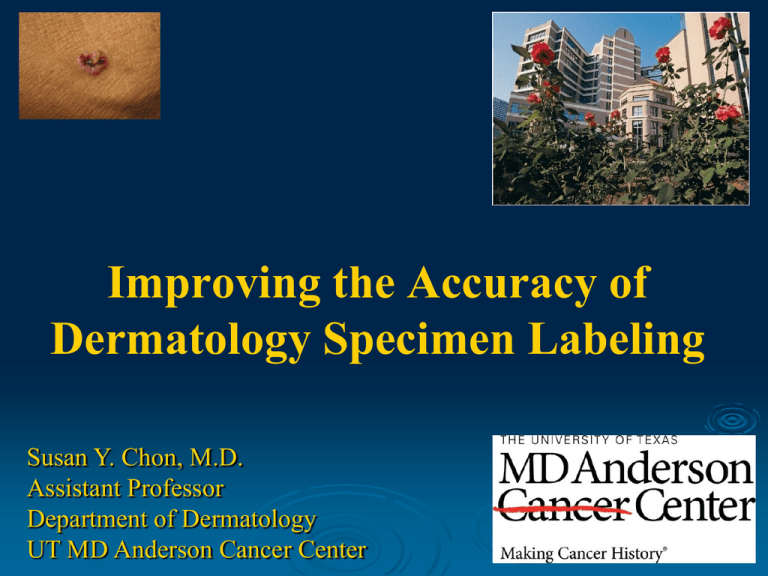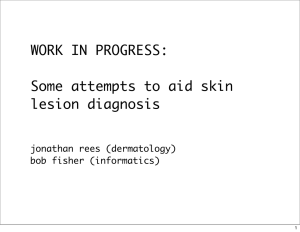Improving Accuracy Dermatology Specimen Labeling
advertisement

Improving the Accuracy of Dermatology Specimen Labeling Susan Y. Chon, M.D. Assistant Professor Department of Dermatology UT MD Anderson Cancer Center Overview of the problem Dermatology specimens are being processed with errors in the Melanoma and Skin Center Clinics Wrong patient name Wrong site Wrong side Missing label Missing pathology form Background Data Dermatology samples are collected and transported in small specimen bottles labeled with the following: Patient Name Specimen source site (body part, left/right) Date taken A pathology form accompanies the specimen to the pathology lab Background Data A mistake (defect) in any of the above information results in, at a minimum rework (corrections and addendums to pathology reports), and can possibly result in diagnosis or treatment errors. During a two week period in the month of February, 13 mislabeled specimens were caught at the Clinic level. Aim Statement Reduce the number of mislabeled specimens from the Department of Dermatology, Melanoma and Skin Center clinics, delivered to the Department of Pathology by 50% by 4Q, 2010 How Will We Know That a Change is an Improvement? A defect is defined as: Any dermatology sample whose label or pathology report has been corrected for site, name, etc. This will be measured by count of defects Our goal is to reduce defects by 50% Total specimens 2009 1 Gastrointestinal 18,144 2 3 4 5 6 7 8 9 Genitourinary Skin Breast Head and Neck Gynecology Thoracic Soft tissue Neuro 14,620 14,529 11,676 9955 5665 4885 1961 1879 10 11 12 13 Bone Hemepath Cytology Unassigned Total 1543 1480 228 137 86,702 Process Analysis Data Gathering Process Mapping The process was observed by multiple people, mapped and refined by the team. Significant variation in the process was observed. Data was gathered for several weeks, which included: 1. 2. 3. 4. MRN Labeling Defects Provider Information re: discovery Cause and Effect Analysis The team used a fishbone diagram to narrow down the suspect causes the actual labels (including handwriting) and the time when the labels are written and entered in the database. Baseline Data – Defect Types “No site written” was the primary defect type, followed by “Wrong patient name” and “Illegible handwriting. ” Total defects at Baseline Baseline surveillance for two weeks between February 15- February 26,2010 Total errors = 13/172 Error rate = 7.6% Benchmarking - CPB A different process was discovered in use in CPB. This process appeared to meet the needs of both departments, and was successful in reducing defects through use of preliminary work and careful double-check. Interventions (Plan) Based on our observations and upon benchmarking CPB, the following interventions were planned: Labels and forms printed prior to entering the patient’s room Labels and forms taken into patient’s room and specimen containers labeled prior to taking specimen Standardized method and abbreviations on the specimen labels Active double check as the specimen is placed in the bottle by physician and MA/RN Proposed Modified Flow (Intervention) The new flow is based on the benchmark, modified as appropriate for use in the main clinic. Pilot & Process Audit Modified flow was in pilot phase during October (10/25-10/29) in the Melanoma and Skin Center Clinics Analysis of the process results showed No defects ( 0/68) Error rate 0% No increase in time or difficulty in adapting to the new process No further process refinements were found Full-scale Implementation Current plan is to monitor implementation to all clinics in the Melanoma and Skin Center Standard procedures, policies and training plans will be put in place as a method of sustainment Return on investment: Benefits to ensuring no mislabels Avoid errors that could severely impact patient care Save physician and staff time 1 hour to correct a pathology specimen. Dermatology and dermatopathology departments spend time hunting down the error. Avoid costly litigation to MD Anderson Cancer Center Summary Recognized a problem with labeling of dermatology specimens Identified critical step in process Implemented and studied pilot with new process Next step: maintaining implementation to all Melanoma and Skin Center Clinics Continue to collect data by monitoring and sustaining the process in clinic The Team Team Members Victor Prieto, MD, Professor, Pathology Susan Y. Chon, M.D., Assistant Professor, Department of Dermatology Lourdes Lujan, RN, OCN, Nurse Manager, Melanoma and Skin Center Alyson Knight, MHA, Hospital Administrative Fellow Marshall Nauck, MEE, AD, Quality Engineering


